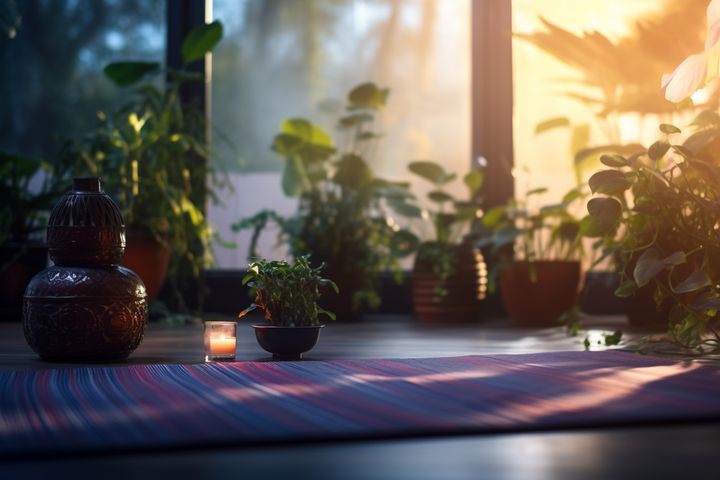Unlock the Secrets of Tree Pose (Vrksasana) for Better Balance
From strengthening your lower body and enhancing focus to opening your hips and aligning your spine, Vrksasana is a versatile asana that caters to practitioners of all levels.

Introduction
Welcome to this comprehensive guide on Tree Pose, also known as Vrksasana. This balancing pose is a staple in many yoga practices and offers a myriad of benefits, both physical and mental. Read on to deepen your understanding and perfect your Tree Pose.
Historical Background of Tree Pose
The Ancient Roots
The origins of Tree Pose can be traced back to ancient India, where yoga was first conceptualized over 5,000 years ago. The pose is known in Sanskrit as Vrksasana (pronounced vrik-SHAH-suh-nuh), where "Vriksha" translates to "tree," and "Asana" means "pose" or "seat."
Symbolism: The Tree of Life
The pose emulates the steady and rooted posture of a tree, thereby symbolizing the balance between earth and sky, body and mind. In various spiritual traditions, trees are considered the embodiment of life, growth, and eternal nature, and practicing Tree Pose is often seen as connecting with these universal energies.
Role in Traditional Yoga Practices
Tree Pose is a component of Hatha Yoga, one of the six original branches of yoga. Hatha Yoga focuses on physical postures and breathing techniques to prepare the body for deeper spiritual practices like meditation. Vrksasana, with its focus on balance and grounding, aligns well with the principles of Hatha Yoga by helping practitioners to center themselves and find stability in body and mind.
Evolution Through Time
Over time, the pose has been adapted and modified to suit various styles of yoga, including Vinyasa, Ashtanga, and Iyengar, among others. Today, it is one of the most widely practiced asanas and is frequently incorporated into yoga classes and sequences worldwide.
Cultural References and Modern Adaptations
While the pose has its roots in ancient yoga philosophy, its concepts of balance, focus, and grounding have made it relevant even in modern contexts. It is often used in yoga therapy and even in workplace wellness programs to help people develop better posture, focus, and stress resilience.
Physical Benefits of Practicing Tree Pose
Strengthening the Lower Body Muscles
Tree Pose provides a dynamic way to engage and strengthen the muscles in the lower extremities. As you balance on one leg, the muscles of the supporting leg—particularly the quadriceps, hamstrings, and calf muscles—are activated, leading to increased muscle tone and strength over time.
Enhancing Balance and Coordination
In today's world where sedentary lifestyles are prevalent, balance and coordination often go overlooked. Vrksasana challenges your sense of balance by requiring you to stand on one foot.
This improves neuromuscular coordination and creates better proprioception, which is the awareness of your body’s position in space.
Improving Posture and Spinal Alignment
Standing tall in Tree Pose encourages upright posture. This is particularly beneficial for those who spend long hours sitting or who have desk jobs. The act of lifting the spine elongates the back muscles, helping to correct posture and reduce the stress on the spinal discs.
Increasing Hip Flexibility and Opening the Hip Joint
As you place one foot on the inner thigh or calf of the opposite leg, the pose acts as a hip opener. Regular practice of Tree Pose can increase the range of motion in the hip joint and reduce stiffness, which is beneficial for people who experience hip or lower back pain.
Engaging the Core
Although it might not be immediately obvious, Tree Pose is also an excellent workout for your core muscles. Keeping your body upright in this one-legged position activates the abdominal muscles, thus promoting better core stability and balance.
Enhancing Foot and Ankle Stability
The act of balancing on one foot significantly engages the muscles in the feet and ankles. This leads to stronger, more resilient feet and ankles, which is beneficial for athletic activities and everyday mobility alike.
Step-by-Step Instructions for Tree Pose
Step 1: Start with Mountain Pose
Begin by standing in Mountain Pose (Tadasana). Keep your feet hip-distance apart and your arms by your sides. Engage your core and lengthen your spine to establish a strong foundation.
Step 2: Shift Your Weight
Shift your weight onto your left foot and lift your right foot off the ground. Keep your left leg engaged but not locked at the knee.
Step 3: Find Your Drishti
Choose a fixed point in front of you to focus your gaze on. This "drishti," or focal point, will help you maintain balance throughout the pose.
Step 4: Position Your Right Foot
Carefully place the sole of your right foot on the inner left thigh, calf, or ankle. Avoid putting your foot on the knee to prevent undue stress on the joint.
Step 5: Align Your Hips
Ensure that your hips are square to the front and that your pelvis is neutral. This will help maintain proper alignment and balance.
Step 6: Bring Hands to Heart Center
Place your palms together in a prayer position at your heart center, or Anjali Mudra. This serves to centralize your energy and further aid balance.
Step 7: Extend Your Arms
If comfortable, extend your arms upwards, reaching towards the sky. Your arms can be straight and parallel, or your palms can touch overhead. Ensure your shoulders are relaxed and away from the ears.
Step 8: Hold and Breathe
Hold the pose for 5-10 breaths, focusing on your drishti and maintaining a steady, rhythmic breathing pattern.
Step 9: Release and Repeat
To release, gently bring your arms back down and place your right foot back on the floor. Return to Mountain Pose before repeating on the other side.
Common Mistakes to Avoid in Tree Pose
Foot Placement on the Knee
One of the most common mistakes in Tree Pose is placing the foot on the knee of the supporting leg. This puts unnecessary pressure on the knee joint and can lead to injury. Aim to place your foot either above or below the knee, on the inner thigh or calf.
Ignoring Hip Alignment
Improper hip alignment can offset your balance and also put undue stress on your hips and lower back. Ensure your hips are square to the front and that your pelvis is in a neutral position.
Overarching the Lower Back
As you reach your arms upward, there’s a tendency to arch the lower back excessively. This can lead to lumbar strain over time. Focus on keeping your core engaged and your pelvis neutral to maintain the natural curve of your spine.
Losing Focus on the Drishti
Maintaining a steady gaze on a fixed point (Drishti) is key for balance. Looking around or letting your gaze wander can disrupt your balance and make it difficult to hold the pose.
Overstraining the Arms and Shoulders
Reaching your arms upwards should not involve scrunching your shoulders or straining your neck. Keep your shoulders relaxed and down, away from your ears, to maintain a lengthened and relaxed posture.
Not Engaging the Core
Forgetting to engage the core muscles can make it difficult to maintain balance and may put extra stress on the lower back. Keep your core engaged throughout the pose to provide stability and support to your spine.
Holding Your Breath
Breathing is a crucial part of any yoga pose. Some practitioners unintentionally hold their breath when trying to maintain balance. Try to keep your breathing steady and rhythmic to help with focus and stability.
Modifications and Variations
Use a Wall for Support
For beginners or those having difficulty balancing, practicing the pose while leaning against a wall can provide additional support and stability. Stand with your back lightly touching a wall as you get into the pose.
Foot Placement Variations
Depending on your level of flexibility and balance, you can place your foot at different heights along the supporting leg. Beginners can start by placing the foot on the ankle or calf, while more advanced practitioners can aim for the inner thigh.
Arm Positions
If fully extending your arms overhead is challenging, you can keep your palms together at heart center. Alternatively, you can extend your arms out to the sides like branches, which can also help with balance.
Toe-Tap Modification
If standing on one foot is particularly challenging, you can keep the toes of your lifted foot on the ground for additional support. This "toe-tap" modification allows you to enjoy many of the pose's benefits while building up your balance and strength for the full version.
Closed-Eye Variation
For an added challenge, try performing Tree Pose with your eyes closed. This will test your balance and proprioception skills, heightening your awareness and focus.
Incorporate Props
Using yoga blocks or straps can help in making the pose more accessible. A block can be placed under the foot of your lifted leg if it doesn’t reach the inner thigh or calf, and a strap can be used to pull up a foot that’s difficult to reach.
Advanced: Add a Twist
For those looking for more challenge, adding a twist to Tree Pose can introduce an additional element of balance and core engagement. With your palms at heart center, gently twist your torso to the side of the lifted leg, then return to center before releasing the pose.
Complementary Poses
Mountain Pose (Tadasana)
Mountain Pose serves as a foundational stance in yoga and is often the starting point for Tree Pose. Practicing Mountain Pose helps in grounding and stabilizing your body, preparing you for the balance challenges of Tree Pose.
Warrior III (Virabhadrasana III)
Warrior III is another balancing pose that works on leg strength and core stability. Adding this to your routine can help you transition more easily into Tree Pose and further refine your balance and focus.
Half Moon Pose (Ardha Chandrasana)
This pose challenges your balance and opens up the hips, similar to Tree Pose. Practicing Half Moon Pose can help to improve your stability and hip flexibility, making Tree Pose more accessible.
Garland Pose (Malasana)
Garland Pose helps in opening up the hips and strengthening the lower body. Practicing this pose can prepare your hips and legs for the hip-opening and balancing aspects of Tree Pose.
Pigeon Pose (Eka Pada Rajakapotasana)
Pigeon Pose is excellent for opening the hips and stretching the thighs, making it a great complement to the hip alignment and leg engagement in Tree Pose. Supported Pigeon Pose is also a great complement to Tree Pose as it provides a gentler hip opening experience while allowing for deeper relaxation and focus
Conclusion: The Holistic Benefits of Tree Pose
Tree Pose is more than just a balancing act; it's a multifaceted yoga pose with deep roots in history, offering numerous physical and mental benefits.
From strengthening your lower body and enhancing focus to opening your hips and aligning your spine, Vrksasana is a versatile asana that caters to practitioners of all levels.
Whether you're a beginner seeking to improve your balance or an advanced yogi looking to deepen your practice, the different modifications and variations can be tailored to meet your needs.



Comments ()